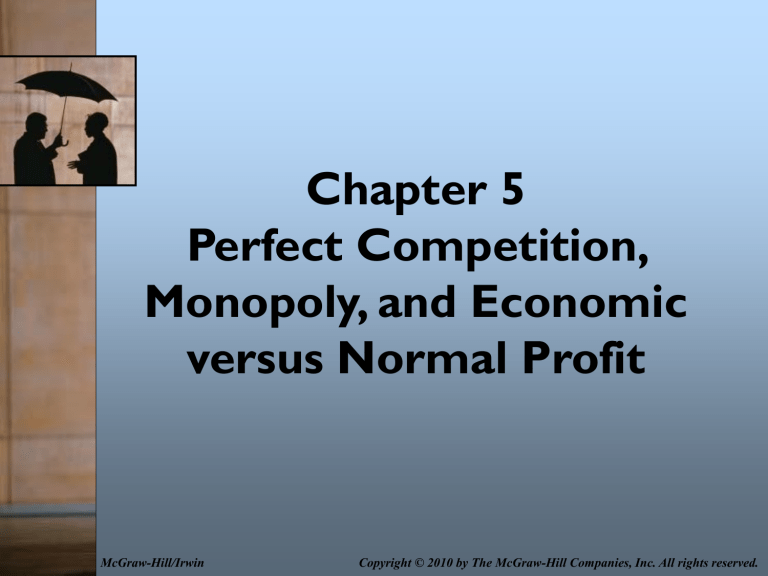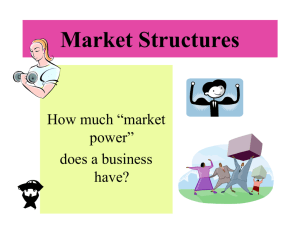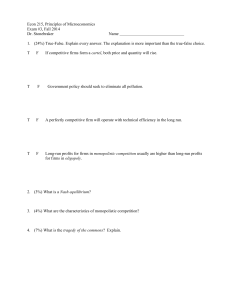
Chapter 5
Perfect Competition,
Monopoly, and Economic
versus Normal Profit
McGraw-Hill/Irwin
Copyright © 2010 by The McGraw-Hill Companies, Inc. All rights reserved.
Chapter Outline
• From Perfect Competition to
Monopoly
• Supply Under Perfect Competition
5-2
You Are Here
5-3
From Perfect Competition to
Monopoly
•
•
•
•
Perfect Competition
Monopolistic Competition
Oligopoly
Monopoly
5-4
Picking the Quantity to Maximize
Profit The Perfectly Competitive
Case
P
MC
ATC
AVC
P*
MR
Q*
Q
Many Competitors
5-5
Picking the Quantity to Maximize
Profit The Monopoly Case
P
MC
ATC
P*
AVC
D
MR
Q*
Q
No Competitors
5-6
Characteristics of Perfect
Competition
• a large number of competitors, such that no
one firm can influence the price
• the good a firm sells is indistinguishable
from the ones its competitors sell
• firms have good sales and cost forecasts
• there is no legal or economic barrier to its
entry into or exit from the market
5-7
Monopoly
• The sole seller of a good or service.
• Some monopolies are generated
because of legal rights (patents and
copyrights).
• Some monopolies are utilities (gas,
water, electricity etc.) that result from
high fixed costs.
5-8
Monopolistic Competition
• Monopolistic Competition: a
situation in a market where there are
many firms producing similar but not
identical goods.
• Example : the fast-food industry.
McDonald’s has a monopoly on the
“Happy Meal” but has much
competition in the market to feed kids
burgers and fries.
5-9
Oligopoly
• Oligopoly: a situation in a market
where there are very few discernible
competitors
• Examples
– Satellite TV service (Direct TV, Dish
Network)
– Airlines (American, Delta etc.)
5-10
Which Model Fits Reality?
• Perfect competition is rare outside
agriculture though it fits some labor
markets.
• Monopolies are common in utilities
• Major branded companies are typically
either in oligopolistic or
monopolistically competitive
industries.
5-11
Examples of Different Market
Forms
Perfect
Competition
Monopolistic Oligopoly
Competition
Monopoly
1) Agriculture
2) Lumber
1) Fast
1) Cars and 1) Windows
Food
Trucks
Operating
system
2) Long
2) Soft
Distance
Drinks
2) Local
Service
Residenti
al electric
power
5-12
Distinguishing Characteristics
Between Market Forms
Perfect
Monopolistic Oligopoly Monopoly
competition Competition
Number
of Firms
Many-often
thousands or
even millions
Several*
Few*
One
Barriers
to Entry
None
Few
Substantial
Insurmountable
, at least in the
short run
Product
Similarity
Identical
Similar but not Similar or
identical
Identical
N/A
* The line between “several” and “few” is not definite
5-13
Concentration Ratios
• there is no magic line that separates
oligopoly from monopolistic competition.
• a “concentration ratio” measures the
percentage of total market sales for the
top firms (from 4 firms to 100 firms).
5-14
Concentration Ratios For Various
Manufacturing Industries
Industry Group
Concentration Ratios
4 Largest Firms
8 Largest Firms
50 Largest Firms
Breakfast
Cereals
78.4%
91.1%
100.0%
Ice Cream
48.0
64.4
93.1
Beer
90.8
93.8
98.1
Clothing
17.3
21.3
38.7
Computers and
Peripherals
40.5
65.2
88.3
Furniture
11.0
18.0
30.6
Long Distance
59.7
80.9
92.5
Cellular Service
61.7
81.7
90.0
5-15
Supply Under Perfect Competition
5-16
Normal vs. Economic Profit
• Normal Profit : the level of profit
that business owners could get in
their next best alternative
investment
• Economic Profit: any profit above
normal profit
5-17
Return on Equity For Various
Industries
Industry
Rate of Return
Net Income/(AssetsLiabilities)
Agriculture
Manufacturing
Transportation and Public
Utilities
Retail Trade
3.1%
21.8%
8.2%
16.1%
5-18
When and Why Economic Profits
Go to Zero
5-19
Time Horizons
• Short Run: the period of time where
we cannot change things like plant and
equipment
• Long Run : the period of time where
we can change things like plant and
equipment
5-20
Market Forms and Economic
Profits
• Under perfect competition or
monopolistic competition, economic
profits go to zero because of the entry of
new firms increases market supply and
lowers prices.
• Economic profits are under no pressure
to shrink under oligopoly or monopoly
because entry doesn’t occur so prices do
not fall.
5-21
Figure 2 The Pressures on Price in
Perfect Competition
$
Long Run
Pressure
MC
MR4
Short Run
Pressure
ATC
AVC
MR3
MR2
MR1
Q
5-22
Figure 3 Points of Production in Perfect
Competition
$
MC
MR4
ATC
AVC
MR3
MR2
MR1
Q
5-23
Figure 4 Supply in Perfect
Competition
$
MC
Supply
ATC
AVC
Q
5-24





